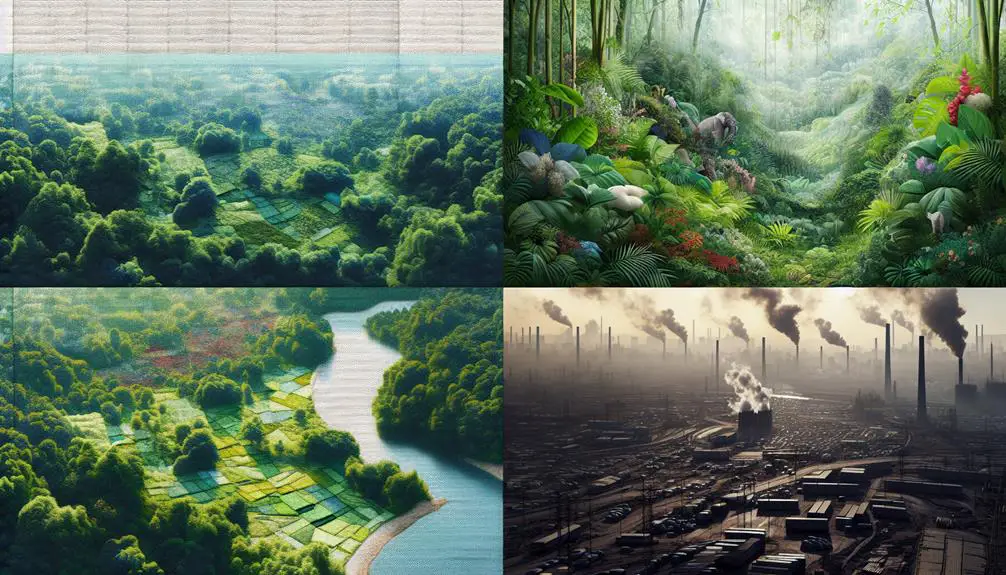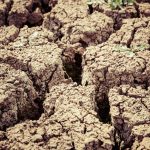You might not realize that producing a single cotton t-shirt can use up to 2,700 liters of water. This staggering fact highlights just one aspect of how different fabrics impact the environment. Polyester, for example, sheds microplastics into waterways, while wool can contribute to soil degradation through overgrazing. Each fabric type has its own set of environmental challenges, and some alternatives like hemp and linen offer more sustainable solutions. Understanding these impacts could change how you view your wardrobe choices and their broader environmental consequences.
Table of Contents
Key Takeaways
- Cotton farming consumes excessive water and large amounts of insecticides and herbicides, depleting local water sources.
- Polyester production releases microplastics and hazardous pollutants, impacting aquatic ecosystems and human health.
- Wool production can cause soil degradation and carbon emissions, but sustainable grazing practices can mitigate these effects.
- Silk production often leads to deforestation and pollution, but alternatives like Tencel offer lower environmental impacts.
- Hemp and linen fabrics require minimal water and pesticides, improve soil health, and are durable and biodegradable.
Cotton's Environmental Footprint
When you consider cotton's environmental footprint, it's important to understand the vast amount of water and pesticides required for its cultivation. Cotton is notorious for its excessive water usage. To produce just one kilogram of cotton, it can take up to 20,000 liters of water. This massive consumption often leads to the depletion of local water sources, causing significant strain on ecosystems and communities.
Pesticide pollution is another critical issue. Cotton farming uses 16% of the world's insecticides and 6% of its herbicides, contributing to soil degradation and the contamination of waterways.
You should also be aware of the impact on soil health. Continuous cotton farming depletes essential nutrients, leading to soil degradation that reduces agricultural productivity over time. This decline in soil quality forces farmers to use even more chemical inputs, creating a vicious cycle.
Additionally, the extensive use of chemical pesticides not only harms the soil but also leads to biodiversity loss. Beneficial insects, birds, and other wildlife are adversely affected, disrupting local ecosystems.
Polyester and Microplastics
When you wash polyester clothes, tiny plastic fibers called microplastics can end up in waterways, posing a threat to marine life.
Additionally, the production of polyester itself consumes significant energy and resources, contributing to environmental pollution.
Understanding these impacts can help you make more sustainable fabric choices.
Microplastics in Waterways
Polyester fabrics, shedding tiny microplastics during washing, greatly contribute to waterway pollution. When you wash your polyester clothes, these microscopic fibers break off and slip through household filtration systems. As a result, they end up in wastewater treatment plants, which often aren't equipped to filter out such tiny particles. This inefficiency leads to significant microplastic pollution in our rivers, lakes, and oceans.
You might wonder why this is a big deal. Here are three reasons:
- Marine Life Impact: Microplastics are ingested by aquatic organisms, causing physical harm and introducing toxic chemicals into the food chain.
- Human Health Risks: Consuming seafood contaminated with microplastics could pose serious health risks to you and your loved ones.
- Ecosystem Disruption: Microplastics can disrupt entire ecosystems by affecting the reproductive and feeding behaviors of aquatic species.
The textile industry's impacts on wastewater systems are profound. Ineffective filtration systems and inadequate wastewater treatment facilities exacerbate the problem, leading to widespread environmental degradation.
Polyester Production Impact
In addition to releasing microplastics during washing, the production of polyester itself significantly contributes to environmental pollution. When you explore the production process, you'll find that it involves substantial energy consumption and waste generation. Polyester is derived from petroleum, a non-renewable resource, leading to significant resource depletion. The extraction and refining of petroleum not only consume vast amounts of energy but also release harmful pollutants into the atmosphere.
You'll also observe that the manufacturing process of polyester emits high pollution levels. Factories release volatile organic compounds (VOCs) and other hazardous substances into the air, contributing to smog and respiratory issues. Additionally, the dyeing and finishing processes often involve toxic chemicals that contaminate water sources, further worsening environmental degradation.
Resource depletion doesn't end with petroleum extraction; it extends to water usage as well. Producing polyester requires large volumes of water, adding strain to already scarce water resources. Furthermore, the waste generation from polyester production is alarming. Solid waste, chemical sludge, and microplastics all end up in landfills and oceans, persisting for centuries.
Wool Production Impacts
When you consider wool production, you need to think about the environmental impacts of grazing and land use. Sheep farming can lead to overgrazing, which affects soil health and local ecosystems.
Additionally, wool production contributes to carbon emissions, adding to the industry's overall environmental footprint.
Grazing and Land Use
Wool production significantly impacts land use due to the extensive grazing needed for sheep. Overgrazing often results in significant soil degradation, which reduces the land's fertility and disrupts local ecosystems. When sheep graze excessively, they strip vegetation, causing soil erosion and loss of native plant species. This not only harms biodiversity but also hampers the land's ability to support future agricultural activities.
To mitigate these negative effects, implementing effective grazing management and participating in conservation efforts are essential. Proper grazing management ensures that sheep are moved regularly, allowing vegetation to recover and preventing soil exhaustion. Conservation efforts may include reforestation projects and the protection of native grasslands, which help maintain ecological balance and improve soil health.
Consider the following steps to enhance sustainable wool production:
- Rotational Grazing: Regularly move sheep between pastures to prevent overgrazing and allow vegetation to regenerate.
- Restoration Projects: Engage in reforestation and native grassland restoration to repair degraded ecosystems.
- Monitoring Programs: Regularly monitor soil health and vegetation conditions to make informed decisions about grazing practices.
Carbon Emissions Levels
Sheep farming consistently contributes to carbon emissions through various stages of wool production. When you consider the entire lifecycle of wool, from shearing to processing, the impact becomes apparent. Energy consumption during the cleaning and dyeing processes markedly elevates carbon emissions. You can't ignore the transportation emissions either, as wool often travels long distances from farms to factories and then to markets. This not only increases the carbon footprint but also exacerbates the problem of textile waste.
Take a look at the following table to get a clearer picture of the environmental impacts associated with wool production:
| Stage of Production | Environmental Impact | Key Factors |
|---|---|---|
| Sheep Farming | High carbon emissions | Methane from digestion |
| Shearing and Processing | Energy consumption | Use of machinery |
| Transportation | Transportation emissions | Long-distance travel |
| Manufacturing | Textile waste | Excess material |
| Disposal | Landfill impact | Non-biodegradable elements |
Bamboo: Pros and Cons
Bamboo fabric offers a range of environmental benefits, but it's important to also take into account its drawbacks. When considering bamboo fabric, sustainability is a significant advantage. Bamboo grows rapidly, requires minimal water, and doesn't need pesticides. This makes it an eco-friendly option compared to conventional cotton.
Additionally, bamboo fabric is known for its durability. It resists wear and tear, making it a long-lasting choice for clothing and textiles.
However, it's crucial to recognize the cons associated with bamboo fabric. The processing method to convert bamboo into fabric often involves harmful chemicals, which can negate its environmental benefits. Furthermore, the production process can release pollutants into the environment, affecting air and water quality.
Here's a quick summary of the pros and cons:
- Pros:
- Sustainability: Rapid growth, minimal water, and no pesticides.
- Durability: Long-lasting and resistant to wear.
- Cons:
- Chemical Processing: Harmful chemicals used in processing.
- Pollution: Potential release of pollutants during production.
Silk and Its Sustainability
Evaluating silk's sustainability reveals both its luxurious appeal and its environmental impact. You can't deny the allure of silk—its smooth texture and elegant sheen make it a prized material.
However, the traditional silk production methods come with significant environmental costs. Raising silkworms requires vast amounts of mulberry leaves, leading to deforestation and loss of biodiversity. Additionally, conventional sericulture often involves harmful chemicals and pesticides, contributing to soil degradation and water pollution.
To tread more lightly on the planet, consider exploring silk alternatives. These sustainability options include materials like Tencel, a fiber derived from sustainably sourced wood pulp, or peace silk, which allows silkworms to complete their life cycle naturally. Both offer a less harmful environmental impact without sacrificing quality.
Hemp Fabric Benefits
Switching from silk to hemp fabric can markedly reduce your environmental footprint. Hemp cultivation methods are inherently more sustainable, requiring less water and fewer pesticides compared to other fibers. By embracing these sustainable practices, you support a farming process that enriches the soil and reduces reliance on harmful chemicals.
Hemp fabric's durability stands out as one of its most compelling benefits. Its fibers are robust and resilient, allowing garments and textiles made from hemp to withstand wear and tear far better than those made from many other materials. You'll find that investing in hemp fabric yields long-lasting benefits, saving you money and reducing waste over time.
To summarize why hemp fabric is an excellent choice, consider these points:
- Eco-Friendly Growing: Hemp cultivation methods use markedly less water and fewer pesticides, promoting sustainable practices.
- Superior Durability: Hemp fabric durability ensures that your items last longer, offering exceptional long-lasting benefits.
- Soil Health: Hemp farming replenishes nutrients in the soil, enhancing agricultural sustainability.
Linen: A Green Choice?
Linen, often celebrated for its breathability and comfort, also stands out for its impressive environmental benefits. When you choose linen, you're embracing one of the most eco-friendly textiles available. Linen is derived from the flax plant, which requires minimal water and almost no pesticides. This makes it a product of sustainable farming practices, reducing its overall environmental impact.
You might appreciate that linen is fully biodegradable, meaning it won't contribute to landfill waste. In addition, flax plants improve soil health, promoting biodiversity and reducing the need for synthetic fertilizers. This is a significant plus if you're keen on supporting sustainable farming.
Linen production also consumes less energy compared to other fabrics, further shrinking its carbon footprint. You'll find that linen garments are incredibly durable, often lasting for many years, which reduces the frequency of replacement and, consequently, waste.
Furthermore, linen's natural fibers are hypoallergenic and breathable, making it an excellent choice for people with sensitive skin. By opting for linen, you're making a conscious decision to support eco-friendly textiles that benefit both the environment and your well-being.
Frequently Asked Questions
How Does Fabric Dyeing Affect Water Pollution?
You'll find that fabric dyeing drastically affects water pollution. It involves significant water consumption and releases chemical waste into waterways. Mastering sustainable practices means reducing these pollutants and conserving water resources effectively.
What Are the Energy Costs of Fabric Production?
When considering the energy costs of fabric production, you must evaluate the carbon footprint and resource consumption. Efficient production methods can minimize both, reducing environmental impact while maintaining high-quality textile output.
Are There Biodegradable Synthetic Fabrics Available?
Yes, you'll find biodegradable synthetics available. These eco-friendly fabrics greatly reduce the environmental impact. They decompose swiftly, sparing the soil from synthetic pollution and ensuring sustainable fashion flourishes for future generations.
How Does Fabric Waste Contribute to Landfill Issues?
You'll notice fabric waste worsens landfill impact noticeably. Effective waste management is important because non-biodegradable fabrics persist for years, releasing harmful chemicals. Mastering waste reduction strategies will help mitigate these environmental challenges.
What Are the Social Impacts of Textile Manufacturing on Workers?
Imagine a mountain of injustice! You must guarantee worker safety and fair wages in textile manufacturing. Without these, workers face hazardous conditions and exploitative pay, undermining their well-being and perpetuating cycles of poverty.
- Where to Buy Sherpa Suede Fabric - July 12, 2025
- How to Draw or Illustrate the Texture of Suede Fabric - July 12, 2025
- What Is Baseball Suede Leather Fabric? - July 12, 2025





